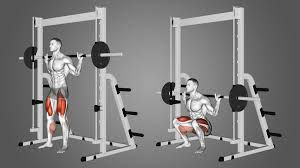Why Young Athletes Shouldn't Rely on Machines: The Case for Mastering Movement, Not Just Muscle
- Laura Baden
- Apr 22
- 4 min read
In the pursuit of elite performance, every training decision matters — especially for young athletes. One common mistake I see in gyms, high schools, and even some sports performance facilities is the overreliance on machine-based resistance training. While machines might look appealing for their simplicity, clean design, and promise of safety, they often come at the cost of long-term athletic development.
Let’s break down why machine lifting can be a trap for athletes — particularly youth and developing athletes — and how it might actually hold back performance instead of propelling it.
The Illusion of Safety: Machines vs. Movement Mastery
At first glance, machines like the leg press, Smith machine, or leg extension seem like a safe way to train. The guided path and external stabilization remove the need to balance or coordinate movement — but that’s exactly the problem.
Athletes don’t compete in fixed planes of motion. They move dynamically — cutting, jumping, pivoting, and accelerating in all three planes. Machines eliminate the need for dynamic stabilization, one of the most critical qualities for injury prevention and athletic efficiency.
Dynamic stabilization is the ability to control movement in real-time using co-contractions of multiple muscle groups — especially the deep stabilizers of the core, hips, and shoulders. Without this, athletes are unstable, inefficient, and more prone to injury.
🧠 Real-World Example:

A squat on a Smith machine forces a straight vertical bar path — but that’s not how human joints naturally move under load. The result? Altered biomechanics and a false sense of strength that doesn’t translate to sport.
Leaving Gains on the Table: Transfer to Sport
The big issue with machine-based training is poor transferability. Sure, you might build muscle or increase isolated joint torque, but you’re leaving athletic performance gains on the table by not training:
Intermuscular coordination
Joint proprioception
Reactive stabilization
Elastic force production
Rate of force development
“Performance is about how well the body works as an integrated system — not how much weight you can leg press.”
The Red Flag: Leg Extensions and Youth Athletes
Few machines are more popular — or problematic — than the leg extension. While it's often used for quad isolation, it's particularly concerning for young or developing athletes.
❌ Here’s why:

Non-functional movement: The leg extension trains knee extension in isolation — a movement rarely performed in sport without hip involvement.
Increased patellofemoral stress: It places high shear forces on the knee joint, which may increase the risk of tendon and cartilage stress in growing athletes.
Tendon loading issues: Research has shown that machine-based open-chain movements like leg extensions may load the patellar tendon in non-beneficial ways compared to closed-chain movements like squats and lunges.
📚 Research Insight:
A 2014 study published in Clinical Journal of Sport Medicine found that open-chain quadriceps exercises like leg extensions produced significantly higher anterior tibial translation and patellofemoral compressive forces than closed-chain movements (Escamilla et al., 2012). These forces can be problematic, particularly in skeletally immature athletes.
Additionally, research by Witvrouw et al. (2001) showed that young athletes with poor neuromuscular control were more susceptible to tendon overuse injuries when subjected to isolated, repetitive machine loading.
Better Alternatives: Functional Training that Builds the Athlete
Instead of isolating muscles, build movements. Young athletes should be learning to control their own body weight, stabilize under dynamic loads, and train through patterns that mimic sport demands.

✔️ Functional Training Priorities:
Squats, lunges, deadlifts — build posterior chain and core control
Unilateral work — split squats, step-ups, single-leg RDLs for balance and symmetry
Med ball work and plyometrics — build rate of force development and dynamic coordination
Rotational and anti-rotational training — train transverse plane stability
Bodyweight and proprioceptive work — enhance joint stability and awareness
🏆 Powered by Science, Backed by Experience: Earn the Edge Performance
At Earn the Edge Performance, we don’t just coach—we educate, assess, and build. Our team is made up of clinically educated sports medicine professionals who understand the nuances of human biomechanics, motor development, and injury risk in youth athletes. We bridge the gap between rehab and high performance with scientifically backed methods.
Whether your athlete is just starting their training journey or aiming for collegiate-level competition, we offer programs that prioritize movement quality, functional strength, and long-term athletic development.
🚀 Our Sports Performance Programs Include:
💪 Youth Strength & Conditioning Group Classes (Ages 10–14)
Focused on learning how to train properly
Emphasis on posture, mobility, and controlled strength
Safe, engaging, and age-appropriate sessions
Foundations in speed, agility, and coordination
🧠 Elite Sports Performance Training (Ages 10+)
Individualized programming based on in depth assessment and consultation
Integrated movement prep, strength, power, and recovery protocols
Ideal for middle school, high school, club, and college athletes looking to reach their full potential
Informed by the latest research in biomechanics and sports performance

🔍 Key Takeaways:
Machines limit dynamic stabilization and neuromuscular coordination.
Leg extensions and other isolation machines may increase joint stress and injury risk in youth.
Functional, compound movements offer better transfer to sport and injury prevention.
Young athletes should develop proprioception, core stability, and body control before loading.
Earn the Edge Performance provides the education, coaching, and environment to do it right.
👉 Ready to help your athlete move better, train smarter, and dominate their sport?
📍 Contact Earn the Edge Performance today to schedule a free movement assessment or learn more about our youth and elite athlete programs.
Train smart. Train strong. Train to Earn the Edge.




Comments